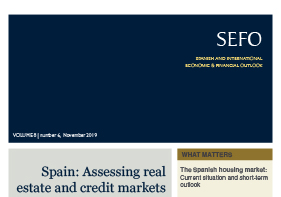
Spain: Assessing real estate and credit markets ahead of an anticipated slowdown
VOLUME 8 I number 6, November 2019
The publication of the November issue of Spanish and International Economic & Financial Outlook (SEFO) follows Spain’s recent general election – the fourth in a four-year period. As the winning Socialist party seeks to form a stable coalition amid investor uncertainty, doubts have resurfaced over the country’s ability to withstand internal and external shocks in the context of a likely slowdown.

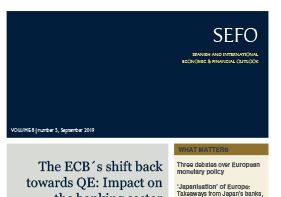
The ECB´s shift back towards QE: Impact on the banking sector
VOLUME 8 | number 5, September 2019
The publication of the September issue of Spanish and International Economic & Financial Outlook (SEFO) coincides with an important turning point in the monetary policy stances of key global central banks, such as the ECB and the Fed, towards a renewed bout of monetary easing. As global headwinds persist and inflation falls below expectations, many of the world’s central banks find themselves back on the path towards exceptionally low rates and accomodation as they struggle to meet their mandates. At the September meeting, the ECB cut rates for the first time since 2016 and announced that it will restart its QE scheme in November. The Fed applied its second rate cut (following the first in July) since 2008 in September and markets are increasing expectations of the return to some form of renewed QE in the near future, particularly after recent tensions in money markets.


The role of Spain's financial sector: Taking stock of key metrics
VOLUME 8 | number 4, July 2019
The July issue of Spanish and International Economic & Financial Outlook (SEFO) follows the European Parliamentary elections, which took place at the end of May. With voter participation among the highest in two decades, the results were deemed among the most significant in years. While voters still largely backed pro-EU parties, with the Social Democrats and the People’s Party still dominant, these traditional centrist blocks appear to have lost their absolute majorities for the first time since European Parliamentary elections were held back in 1979.

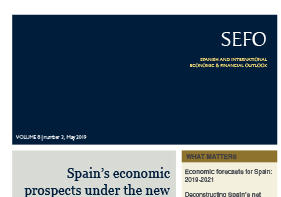
Spain’s economic prospects under the new administration
VOLUME 8 | number 3, May 2019
May’s Spanish and International Economic & Financial Outlook (SEFO) ushers in a recently elected Socialist government for an upcoming four-year term. In this context, we see it an appropriate time to assess Spain’s medium-term economic outlook and key risks the country may face while under the current administration.


Spain’s financial sector: Challenges and risks
VOLUME 8 I number 2, March 2019
The March issue of Spanish and International Economic & Financial Outlook (SEFO) comes out just weeks after the ECB’s surprise announcement to delay the start of its interest rate normalization cycle at least through the end of the year, relative to prior expectations of a rate hike sometime in the third quarter of 2019.


Spain’s near and medium-term economic outlook: Progress and challenges
VOLUME 8 I number 1, January 2019
In the first issue of Spanish and International Economic & Financial Outlook (SEFO) of this year, we take a look at prospects for the Spanish economy in 2019-2021 against the backdrop of a challenging global, not least European, economic environment.


Spanish and EU banks: Recent performance and strategies
VOLUME 7 | number 6, November 2018
EU bank’s today are stronger and more resilient than they were prior to the crisis. However, they are still dealing with a difficult operating environment, both at the global/macro and sector levels.

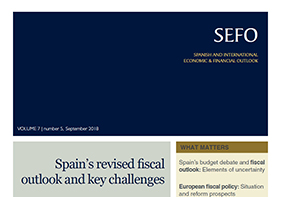
Spain’s revised fiscal outlook and key challenges
VOLUME 7 | number 5, September 2018
The September issue of Spanish and International Economic & Financial Outlook (SEFO) comes at a time when Spain’s fiscal outlook takes centre stage. In this context, we start off this issue with an assessment of the budget debate and its implications not only for fiscal deficit targets for this year, but also for consolidation over the medium-term.


EU financial conditions and Spanish banks
VOLUME 7 | number 4, July 2018
The July issue of Spanish and International Economic & Financial Outlook (SEFO) is the first to be published following the recent, and wholly unexpected, transition to power of Spain’s Socialist Party after winning a parliamentary no-confidence vote against former Popular Party President Rajoy last June...


Spain in the digital era
VOLUME 7 | number 3, May 2018
The advent of new technologies, such as blockchain, has created a set of potential opportunities, still not fully tapped, in financial markets. At the same time, technological innovation in financial services (FinTech) has led to the emergence of numerous initiatives that,...

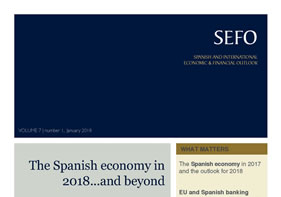
The Spanish economy in 2018.....and beyond
VOLUME 7 | number 1, January 2018
The positive momento of global growth at the end of last year is expected to persist in 2018, with monetary policy gradually tightening, but remaining accommodative enough to sustain the better than expected scenario observed across both advanced, in particular European, and most emerging economies.

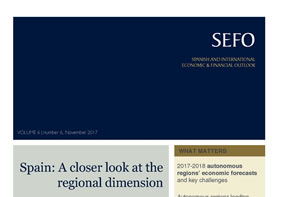
Spain: A closer look at the regional dimension
VOLUME 6 | number 6, November 2017
As political tensions in Catalunya persist, we start the November issue of Spanish and International Economic & Financial Outlook (SEFO) with an in-depth outlook for the Spanish economy overall, together with a breakdown of perspectives for the regional dimension.

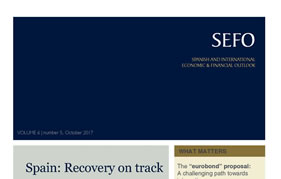
Spain: Recovery on track
VOLUME 6 | number 5, October 2017
The October issue of Spanish and International Economic & Financial Outlook (SEFO) comes at an important political moment for Europe. For the region as a whole, with Germany’s elections now concluded, uncertainty surrounding important elections in key EU countries has largely dissipated. At the same time, domestic political tensions in Spain remain high over Catalonia.

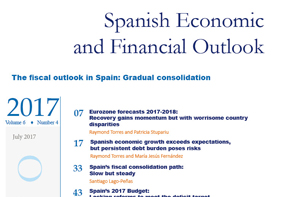
The fiscal outlook in Spain: Gradual consolidation
VOLUME 6 I number 4, July 2017
We initiate this month’s SEFO with the first time ever publication of Funcas’ eurozone forecasts. The eurozone economy has improved significantly. Recent indicators point to a recovery in both domestic demand and exports. This is due to the continuation of the low interest rate environment, stemming from ultra-expansive ECB policy, the recovery in international markets and increased optimism among consumers and companies.

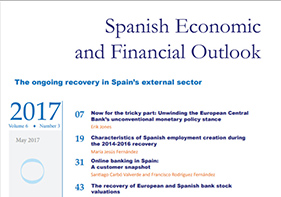
The ongoing recovery in Spain’s external sector
VOLUME 6 | Number 3, May 2017
we kick off the May issues of Spanish Economic and Financial Outlook (SEFO) by looking at the economic situation in the Eurozone. As we point out, the Eurozone recovery is taking root...


The Spanish banking sector: Recovery in a European context
VOLUME 6 | Number 2, Mach 2017
In the context of the Eurozone recovery, Spain continues to outperform the rest of the single currency area. The March issue of Spanish Economic and Financial Outlook (SEFO) starts off by taking a look at outstanding structural obstacles to improving the Euro area’s growth potential and the possible risks of failing to do so for the ongoing recoveries...

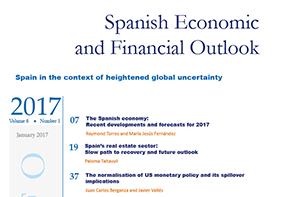
Spain in the context of heightened global uncertainty
VOLUME 6 | number 1, January 2017
In the January issue of Spanish Economic and Financial Outlook (SEF0), we focus on how two highly significant events of 2016 – the election of Donald Trump and Brexit –may unfold in 2017 and what could be their possible implications for the Spanish economy and financial sector over the near to medium term.


Spanish banks: Resisting a difficult climate
VOLUME 5 | Number 6, November 2016
Since the publication of the previous issue of Spanish Economic and Financial Outlook (SEFO), the election of Donald Trump in the US this November is arguably the biggest game-changing event to hit the US (and the global) economy by recent historical standards.

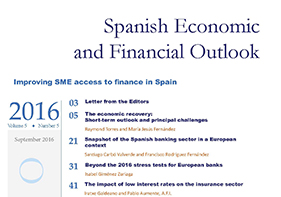
Improving SME access to finance in Spain
VOLUME 5 | Number 5, September 2016
This month’s Spanish Economic and Financial Outlook (SEFO) confirms Spain´s economic recovery as a reality; yet, recent indicators point to the beginning of a slowdown to be felt over the course of the coming year, mostly driven by the slowdown in domestic demand, as well as external factors.

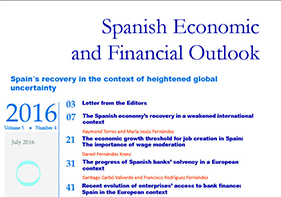
Spain´s recovery in the context of heightened global uncertainty
VOLUME 5 | Number 4, July 2016
Since the publication of the latest edition of Spanish Economic and Financial Outlook (SEFO) last May, two landmark events have taken place. Domestically, Spain´s follow-up, general elections on June 26th should bring increased political stability to the Spanish economy and financial sector. Internationally, the result of the United Kingdom´s referendum to leave the EU has significantly increased the climate of global uncertainty. In addition to Brexit, the global economic context has deteriorated as a result of renewed turbulence in European banking systems, driven by concerns over the soundness of Italian banks, together with general doubts regarding the ability of the EU to stimulate growth and create jobs. Moreover, there has been a weakening of economic growth in emerging economies, notably China and Latin America.


European banks in the face of new regulatory pressures
VOLUME 5 | Number 3, May 2016
2016 has been a difficult year for the European banking sector. Unique global market conditions, with negative interest rates, are major factors in the current difficulties. The banking industry business model is facing a shift driven by new technologies, overcapacity, a legacy of losses from the crisis and serious downward pressure on returns.


Spain´s economy and financial sector: What to expect in the new legislative term
VOLUME 5 | Number 1, January 2016
2015 was a key year for the global economy. The slowdown in China led to a collapse in commodity prices, dragging down many emerging markets (EM) exporters. The Federal Reserve began its interest rate hike cycle, with implications for the dollar and additional downside risks for EM, while the ECB continued on a path of quantitative easing. The divergent EU and US monetary policy stance, together with continued uncertainty over the situation in China and other EM, will be the main factors to watch in 2016.


Spain´s financial sector post-restructuring: Credit recovers amidst outstanding challenges
VOLUME 4 | Number 6, November 2015
Deleveraging has been one of the most frequently used terms in reports on Spain in recent years. It is generally understood to be a rebalancing that demands short-term sacrifices but supports long-term growth and remains a necessary condition for the consolidation of the Spanish recovery. In this context, the November issue of Spanish Economic and Financial Outlook (SEFO) starts off by taking stock of progress on the deleveraging efforts of Spanish households and firms over recent years.

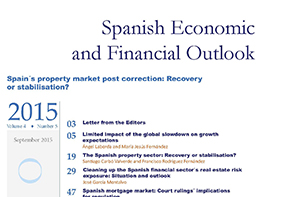
Spain´s property market post correction: Recovery or stabilisation?
VOLUME 4 | Number 5, September 2015
The Spanish recovery remains strong and growth on track for 2015 at 3.2%. We believe the impact of the worsening global outlook will be limited and offset by beneficial factors, such as the drop in oil prices and other commodities, together with income tax cuts being brought forward. Given that the effect of the positive transient factors will have worn off, growth in 2016 has been revised downward modestly by two tenths of a percent, to 2.8%. The main risks to Spain´s forecast scenario will be a worse than expected deterioration in the external context, or a possible intensification of domestic political uncertainties, related to the recent elections in Catalonia and the upcoming general elections before year-end.
